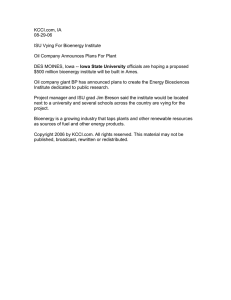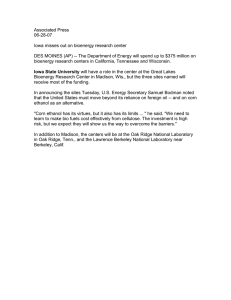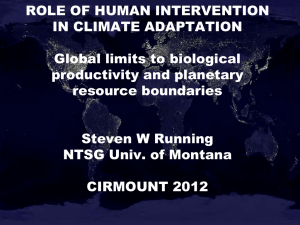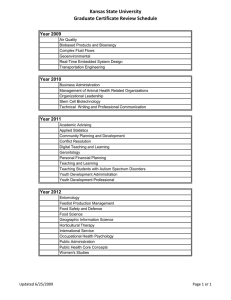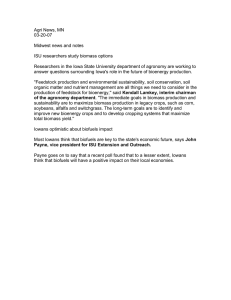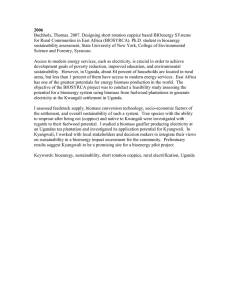Role of Biotechnologies for Biofuel Production in Developing Countries The Bioenergy dimension
advertisement
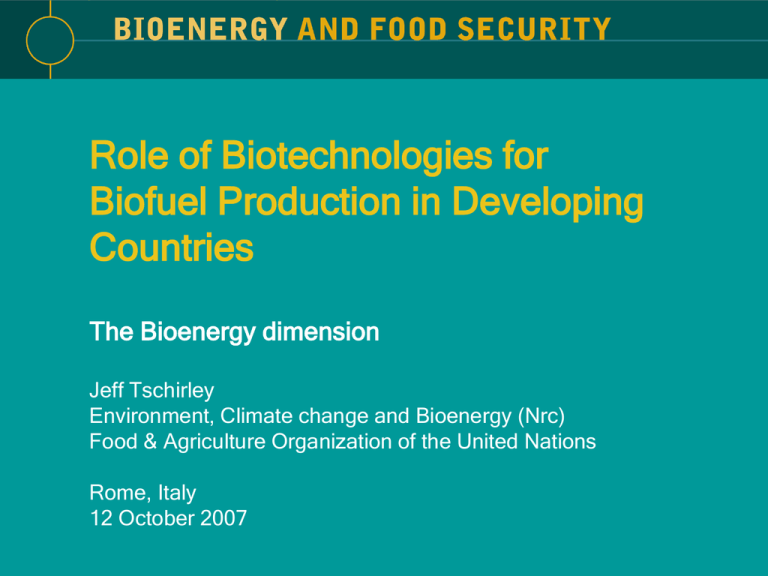
Role of Biotechnologies for Biofuel Production in Developing Countries The Bioenergy dimension Jeff Tschirley Environment, Climate change and Bioenergy (Nrc) Food & Agriculture Organization of the United Nations Rome, Italy 12 October 2007 Food security issues Food availability, access, stability and use Fluctuations and increases in food commodity prices Food availability at times of crisis Restrictions on access to markets Tradeoffs in different bioenergy systems as regards rural employment, income opportunities Where are the hungry? Countries in transition 25 Sub-Saharan Africa 206 Near East and North Africa 38 Latin America and Caribbean 52 Developed market economies 9 854 million (820 in developing countries) Asia and Pacific 524 212 million India 150 million China Environmental and sustainability issues Rapid land use change Land rights and tenure Total land availability Availability and quality of water resources Effects of agro-chemicals Distribution of benefits Wages, rural employment Some key questions What are the bioenergy options for food insecure countries – trade, employment, technology? How may fluctuating commodity prices – potentially positive for producers, negative for poor consumers – affect food availability? Can inequities (land tenure, market access, etc) be reduced? Who is best placed to anticipate, monitor and address conflicts? How may changing bioenergy technology (1st v. 2nd generation) affect tropical developing countries? How is FAO contributing? Bioenergy programme facility - direct assistance to countries, guidelines, data, country analysis Knowledge – Webshore http://www.bioenergywebshore.com International bioenergy information system (iBis) Partnerships – International Bioenergy Platform, Global Bioenergy Partnership Analysis – BEFS, SOFA 2008 Structural and programme re-orientation Fuel Feedstock Currently produced GHG reduction v. petroleum Production cost Biofuels yield per hectare Land types 1st generation biofuels, commercially available Ethanol Biodiesel FAME) (SVO, grains (wheat, maize) US, Europe, China low-moderate moderate moderate cropland oil seeds (rape, soy, sunflower) US, Europe low-moderate moderate low cropland 1st generation biofuels (commercially available mainly in developing countries) Ethanol sugar cane Brazil, India, Thailand high low-moderate high croplands coastal lands all land Biodiesel/SVO palm oil Southeast Asia moderate low-moderate moderatehigh Biogas (CNG) wastes, crops Europe, India high low-moderate high 2nd generation biofuels (not yet commercially available) Biodiesel (BTL) cellulose residues none none high high high croplands, marginal lands moderate-high* high croplands, marginal lands low-moderate degraded lands high all land moderate-high* Other Biodiesel/SVO jatropha South Asia, Africa Biogas (SNG, GtL) biomass, residues all high moderatehigh** high moderate Fritsche, 2007 Ethanol cellulose, residues fossil diesel 1st generation biodiesel 2nd generation biodiesel 1st + 2nd generation EtOH CNG 500 400 350 300 250 200 150 100 50 m ai ze na tu ra lg as bi og as wo od ga s ? Ct L ra pe se ed pa lm oi Hl pa lm oi sh l j or at t-r ro ph ot at a io pe n re w nn oo ia d lg ra ss es bi og as -G tL ga so lin e m ai ze ca ss av su a ga rc an e 0 di es el g CO2-eq per kWh fuel 450 GHG emissions from transport fuels; data in g/kWh incl. upstream life-cycles and by-product credits (from: GEMIS 4.4) Some key challenges Policy and legislative frameworks that facilitate sustainable approaches to bioenergy development Estimating national bioenergy production potential with sufficient accuracy for informed national decisions Coordinating bioenergy investment flows against realistic policy and programme objectives Certifications schemes that are flexible, cost effective and do not penalize participation by small-scale producers Mechanisms for developing countries to compete with technological change Thank you
